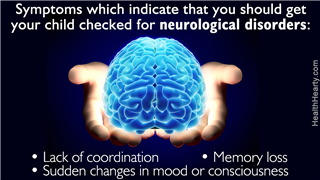
Neurological disorders, which are disorders that affect the brain, spinal cord, and nerves, could also affect children. This article provides a list of pediatric neurological disorders.
The nervous system of the human body comprises the central nervous system and the peripheral nervous system. The former includes the brain and the spinal cord, whereas the latter is a network of nerves that connects the brain and the spinal cord to the rest of the body.
The movement of the muscles and the working of the organs of the body is dependent on the communication between the brain and the rest of the body. If this communication link is adversely affected, or any structure of the nervous system gets damaged due to an injury or disease, it could give rise to a host of problems.
Neurological disorders could affect people of all age groups. These could be congenital or acquired in nature. The following sections list out the neurological conditions that affect children.
Underlying Causes
Neurological conditions could affect the central nervous system or the peripheral nervous system. Some of these disorders might even be present at birth. Genetic factors, trauma, exposure to toxins, tumors, infections, etc., could play a role.
Some of these neurological disorders could cause development delays, or symptoms such as seizures, an abnormal increase in head size, muscle rigidity, lack of coordination, etc. Traumatic brain injuries that occur due to a motor accident, near drowning accident, fall from a height, etc., could be the contributing factors.
At times, neurological complications could occur due to infections such as malaria, encephalitis, or meningitis. Genetics could play an important role in the development of neurological disorders in children. If the mother was an alcoholic or drug addict, it may cause a congenital defect or neurological disease in the offspring.
Associated Symptoms
Some of the following symptoms might be observed in children affected by neurological disorders:
- Developmental milestone delay
- Abnormal head size
- Lack of coordination
- Sudden changes in mood or consciousness
- Muscle rigidity
- Tremors or seizures
- Persistent headaches in older children
- Loss of feeling and tingling sensation
- Muscle weakness
- Paralysis
- Loss of consciousness
- Memory loss
- Muscle spasms or convulsions
- Disorientation
List of Neurological Problems in Children
Common, rare, congenital, and hereditary neurological disorders are listed below:
Neurological Conditions in Newborns
- Intraventricular hemorrhage (Bleeding in the ventricles of the brain; likely to affect premature babies)
- Periventricular leukomalacia (Lack of oxygen or blood flow to the periventricular area of the brain resulting in the death or loss of brain tissue; likely to affect premature babies)
Congenital and Hereditary Neurological Conditions
- Anencephaly (Baby is born without certain parts of the brain and skull)
- Cerebral Palsy (Group of disorders that affects the ability to move and to maintain balance and posture) Chiari Malformation (condition in which brain tissue extends into the spinal canal)
- Craniosynostosis (Brain abnormality that prevents the brain from developing normally)
- Hydrocephalus (Fluid buildup in the cavities deep within the brain due to head injuries, strokes, infections, tumors, or bleeding in the brain)
- Microcephaly (Genetic abnormality that causes an abnormally small head)
- Spina Bifida Occulta (Birth defect in which the baby’s spinal cord doesn’t develop properly)
Common Pediatric Neurological Conditions
- Brain tumor (Development of growth in brain due to uncontrolled or abnormal division of cells)
- Cerebral palsy
- Chiari malformation
- Craniofacial abnormalities (Birth defects of the face and the skull)
- Craniosynostosis
- Developmental disorders (Disorders that interrupt normal development in childhood)
- Epilepsy (Seizures due to disturbance in the nerve cell activity in the brain)
- Walking and/or gait disorders
- Gilles de la Tourette syndrome (Condition characterized by repetitive movements or unwanted sounds)
- Hydrocephalus
- Hypotonia (Low muscle tone, reduced muscle strength)
- Metabolic diseases (Conditions wherein abnormal chemical reactions disrupt the metabolic processes)
- Migraine headache with other symptoms such as nausea, vomiting, dizziness, sensitivity to touch, sound, light, and odors, abdominal pain, and mood changes)
- Movement disorders
- Spina bifida (Developmental congenital disorder wherein the spine doesn’t develop properly)
- Spasticity (Stiff or rigid muscles that adversely affect the ability to walk, move, or talk)
- Spine tumor (Development of a growth within the spinal canal or within the bones of the spine due to uncontrolled and abnormal cell division)
- Spinal cord, nerve, and muscle diseases
- Tethered cord syndrome (Tissue attachments limit the movement of the spinal cord within the spinal column, thereby causing an abnormal stretching of the spinal cord)
- Tremors (Involuntary muscle contraction and relaxation that causes rhythmic shaking)
Rare Neurological Conditions
Adrenoleukodystrophy (ALD)
Adrenoleukodystrophy (ALD) or Schilder’s disease belongs to the group of genetic disorders called leukodystrophies. It is a rare disorder wherein damage to the myelin sheath (a protective membrane that coats the nerve cell) causes progressive brain damage. It also damages the adrenal gland.
Alexander Disease
Alexander disease is a slowly progressing neurodegenerative disease that occurs due to a genetic mutation. This neurological disorder causes developmental delay and changes in the physical characteristics of the child.
Childhood Disintegrative Disorder (CDD)
Childhood disintegrative disorder is also known as disintegrative psychosis and Heller’s syndrome. This is one of the rare neurological ailments in children that occurs before the age of three years. It causes developmental delay related to language, motor skills, and social functioning of the child.
Krabbe Disease
Krabbe disease is also called galactosylceramide lipidosis or globoid cell leukodystrophy. This is a very rare degenerative disorder that occurs due to damage to the myelin sheath of the nervous system. It causes fever, stiffness, irritability, feeding difficulty, vomiting, and slow mental and motor development in child.
Subacute Necrotizing Encephalomyelopathy (SNEM)
Also known as Leigh’s disease, SNEM is a rare neurometabolic disorder. This disease affects the central nervous system of children between the age of three months to two years. The affected children lose control over their movements. They are unable to suck properly and lose head control. They experience symptoms such as vomiting, irritability, continuous bouts of crying (in infants), seizures, and loss of appetite.
On a concluding note, parents must consult a pediatrician, if their child is not developing as per the development milestones. Watch out for any abnormal changes in the child’s appearance or behavior. Early medical intervention can certainly help improve the quality of life of a child affected by a neurological disorder.
Disclaimer
This article is for informative purposes only, and should not be used as a replacement for expert medical advice.





